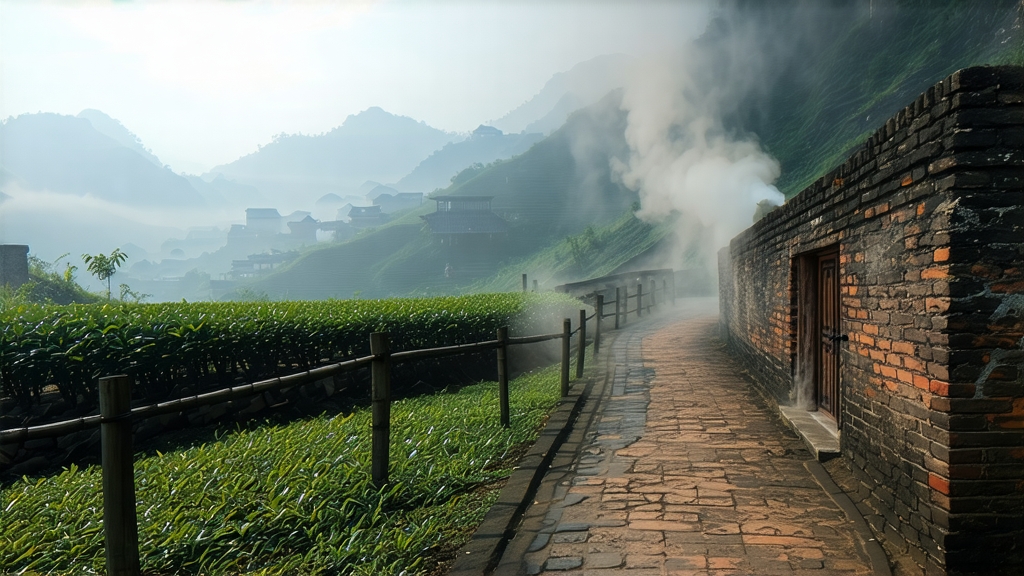
Tucked away in the humid, karst-pitted mountains of southern Guangxi, Liu Bao cha has spent four centuries perfecting the art of quiet transformation. To most outsiders “dark tea” begins and ends with Yunnan’s Pu-erh, yet Liu Bao is the older, subtler sibling that once fueled the Tea Horse Road and still perfumes the morning markets of Wuzhou with the scent of damp earth, betel nut and long-forgotten spices. Understanding Liu Bao is less about chasing a single flavour than about witnessing time being folded into leaf: every brick, basket or loose coil is an archive of Ming-dynary trade routes, Qing-era medicine chests, and the slow microbial dialogue between tea, air and human intuition.
Historical footprints
The name simply means “Six Forts,” a nod to the six staging depots that once guarded the mountain pass linking Guangxi’s tea hinterlands to the Xi River and, eventually, to the South China Sea. By the late Ming, Liu Bao was already compressed into tight leaf cakes, loaded onto bamboo rafts and floated downstream to Guangzhou’s Thirteen Factories, where foreign clipper ships traded it for Southeast Asian spices and Malayan tin. In the Qing it was listed in the Imperial Pharmacopoeia as “xiao shi cha” – tea that dissolves grease – and caravans carried it westward to Tibet, where its ability to aid digestion at 4 000 m elevation earned it the nickname “yak butter whisperer.” When the Tea Horse Road withered in the 1950s Liu Bao retreated into domestic obscurity, ageing quietly in state warehouses until the 2006 dark-tea boom rediscovered its velvet depth.
Micro-terroirs within one county
Although the county of Cangwu is barely 100 km across, its valleys fracture into three distinct aroma zones. The highest, at 800–1 000 m, is the mist-laced “cloud belt” where tea bushes root into iron-rich laterite; leaf grown here develops a camphor-cool top note that recalls old-growth fir. Mid-elevation slopes of red sandstone give leaves a sweeter, jujube-like middle while the lowest alluvial flats, flooded annually by the Xun River, yield broader leaves with a heavier, taro-root body. Traditionally these three leaf styles were blended after firing to create the classic “three-layer” Liu Bao profile: camphor arrival, jujube heart, taro finish.
From green to dark in fifteen weeks
Unlike Pu-erh, which begins as sun-dried shai qing mao cha, Liu Bao undergoes a unique “pile-fermentation in bamboo baskets” that compresses microbial activity into a furious three-month sprint. Fresh leaves are pan-killed at 280 °C for eight minutes, just enough to destroy leaf enzymes while preserving surface microbes. After a 45-minute rolling they receive a 90-second “flash roast” at 140 °C, a step that drives off grassy volatiles and caramelises leaf edges, creating the honeyed precursor later transformed into betel-nut aroma. The still-warm leaves are then stuffed—still slightly tacky—into two-metre-long bamboo cylinders lined with wild banana leaf. The cylinders are stacked in a humid underground chamber kept at 28 °C and 85 % RH. Over the next twelve weeks the tea is turned every seven days; each turn involves unwrapping the banana leaf, hand-tossing the leaves to re-oxygenate the pile, then re-wrapping and weighing the basket down with river stones. The result is a controlled succession of microbes: first the yeasts (Cyberlindnera, Pichia) that generate floral esters, then Lactobacillus that softens astringency, finally Bacillus that breaks cellulose into soluble sugars and produces the trademark “chen xiang” (aged incense) note. When the leaf core hits 65 °C the pile is dismantled, sun-dried for three days, and allowed to rest one lunar month before compression.
Forms of compression and their ageing dialects
Liu Bao is pressed into four traditional shapes, each dictating oxygen flow and therefore ageing trajectory. The 500 g “pillow brick” (zhen cha) is wrapped in rice-paper then rammed into a cedar box; its flat profile allows slow, even oxidation and is preferred by collectors seeking a mellow, woody character after fifteen years. The